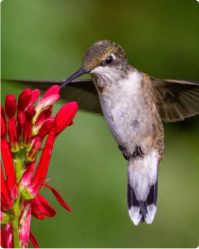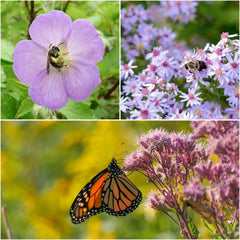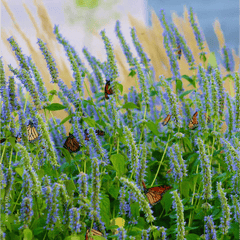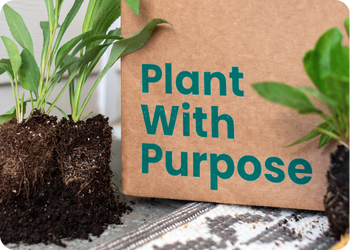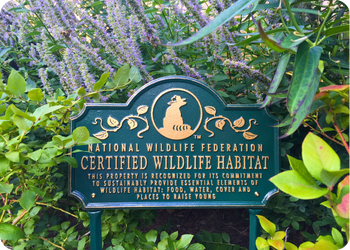General
Email us at info@gardenforwildlife.com.
We currently accept all major credit cards and PayPal.
We do not have a referral program, but hope to offer one in the near future.
We do not accept orders by phone at this time.
When you place an order, we will automatically add you to our email list for product updates and releases, news about the impact our Garden for Wildlife members are making, wildlife gardening tips, and more. You can unsubscribe from these emails at any time.
Please visit our learn page for more information about the Garden for Wildlife program and the positive impact our members are making.
How thoughtful of you! Yes, you can purchase gift cards for any of our plant collections. The gift cards will be emailed to you.
To send a gift, enter your gift recipient’s name and mailing address in the Ship To fields when placing your order. Please make sure your recipient lives in an area for which we have native plants, and that they will be in town when the plants will be shipped. Alternatively, you can purchase a gift card and allow your recipient to place their order when the timing is best for them.
Orders & Shipping
Once your order is placed, we cannot make changes. We are confident you will love your plants and make a beautiful haven for wildlife and yourself.
We work hard to make sure you receive healthy plants that will lead to a thriving wildlife garden. We grow and care for your plants until the timing is best to send them your way. Shipping time frames are based on your USDA Plant Hardiness Zone and usually after the last frost date for your area.
Learn more about our Shipping Timeframes here.
Don't know your Zone? Check here
When your order ships, you will receive an email from orders@gardenforwildlife with tracking information.
If you need to change your shipping address, please contact orders@gardenforwildlife.com.
Please contact orders@gardenforwildlife.com.
A signature is not required to receive your shipment. However, we highly recommend that you remove your plants from their packaging as soon as possible, ideally within an hour. Tracking updates provided by email will allow you to monitor when your plants should arrive. Garden for Wildlife is not responsible for plants left in harsh weather conditions, such as hot sun or heavy rain.
Plants are being shipped with an established root base and some foliage to ensure protection in shipping and easy-to-plant size. It’s important to note that plants are living things, so each one will have slight variations in color, size, and shape. Additionally, our photos might have been taken at a different life stage of the plant.
Plants & Products
Your plants will arrive secured in sleeves of small containers made from recycled plastic. The plants will arrive with developed root mass and emerging foliage.
You should remove your plants from their packaging as soon as possible, ideally within an hour of their arrival. It is best to store them in the area where you plan to plant them, even if you aren’t able to put them in the ground (or planter) just yet. Check your plants’ soil for moisture and add water if dry. We recommend planting within the week your package arrives. Please note that the amount of soil shipped with the plants is minimal and will dry out quickly, so please don’t leave them in bright sun or high heat conditions nor without water for much time.
Our plants are not treated with neonicotinoids. Sustainable gardening means reducing, or, even better, totally eliminating the use of chemical pesticides in your yard. Unfortunately, there is a class of insecticides that are commonly used in the garden trade called neonicotinoids. Studies show that neonicotinoids affect more than just targeted pest insects; they are also harmful to beneficial pollinating insects including bees and butterflies, and some birds.
Our plants are cultivated each season to provide a good root base and approximately 3 inches of plant growth. This size ships securely and is ready to plant. You can anticipate seeing bloom in 1 to 2 months as the plants grow through spring into summer.
We are focused on expansion and our goal is to offer native plants nationwide. You can learn more about the areas we currently support here. You can also register on our site to let us know you’re interested and we will notify you by email when we have native plants for your area.
You can learn more about the areas we currently support here.
The butterflies, moths, bees, and birds supported by the Garden for Wildlife native plant collections have an interdependent connection to each other’s and to our planet’s survival. While some collections include a special host plant for a particular declining species, they are generally curated to provide a diverse palette of pollen, nectar, and insects that support many animals. The majority of wildlife supported are pollinators essential to the reproduction of nearly 85 percent of the world’s flowering plants. Of these, bees are critical to the survival of flowering plants, helping produce more than a third of all the foods we eat.
Yes, the native bees attracted to your wildlife garden are gentle, fascinating creatures solely focused on finding nectar and pollen, not you. The majority of native bees in the U.S. are solitary bees that do not have hives to protect and are not aggressive. The other type of bees—those you might be afraid of—are social bees that live in hives and include native bumblebees and the non-native European honeybee. These social bees, along with social wasp species *may* also seek nectar from your plants. However, they will only sting if their hive/nest is threatened. And in these cases, only female bees can sting.
In general, a bee will only sting if they are hit directly, feel threatened, or accidentally get caught in clothing or hair. If it helps, try to remember that bees are critical to the survival of flowering plants that help produce more than a third of all the foods we eat. So really, bees are our friends.
Certifying Your Wildlife Garden
National Wildlife Federation has been recognizing wildlife gardens as Certified Wildlife Habitats® for fifty years. Certifying is a visible commitment to gardening in a way that helps wildlife and the environment. There are 5 key elements that make your garden eligible for certification:
1. Food
2. Cover
4. Sustainable Practices (Our plants our chemical-free and non-invasive.)
5. Water
When you plant a Garden for Wildlife native plant collection, you are immediately providing 4 of these 5 elements, and the final step is easy…. Just add a water source for the wildlife that visits your garden. You can provide this habitat component in a variety of ways, from a simple birdbath or shallow dish of water to a water garden or pond. Add this element to your Garden for Wildlife native plant collection and you are eligible to Certify.
When you certify, your $20 application fee supports the National Wildlife Federation's programs to inspire others to make a difference and address the issues leading to declining habitat for wildlife nationwide. A portion of your fee also supports work for local wildlife in select affiliate partner states.
Additional benefits include:
• Personalized certificate
• A one-year membership in the National Wildlife Federation and subscription to National Wildlife® magazine
• 10% off the National Wildlife Federation catalog merchandise, including nesting boxes, feeders, birdbaths, and other items to enhance your wildlife garden
• Subscription to monthly Garden for Wildlife e-newsletter with gardening tips, wildlife stories, and other resources
• Exclusive option to purchase attractive garden signs designating your garden as a Certified Wildlife Habitat® with the National Wildlife Federation
If you meet the certification criteria (reminder: you just need a Garden for Wildlife native plant collection and a water source for visiting wildlife), you’re all set. Certify your garden here.
Find out what's blooming.
Sign up for updates on new releases, sales, plant care tips, and more.


